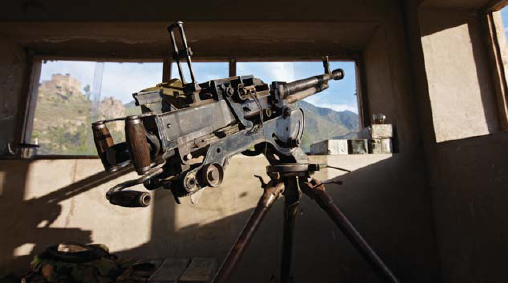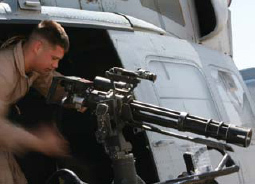The old style .30in and .50in Browning machine guns, together with some heavier machine guns today, use a form of recoil action where the energy from the recoil of the barrel is transmitted to the working parts which causes them to move backwards, extract the empty case, pick up a fresh round and feed it into the breech. These tend to fire slower than gas operated guns but they are very reliable.
Some of the latest high-speed machine guns are powered externally by electric motors so as to achieve very high rates of fire. A very high rate of fire becomes useful when you have only a short time to fire such as a ground attack aircraft passing over the target.
Ammunition feed: To sustain a high rate of fire it is impractical to feed from a magazine as it cannot contain enough rounds to last for more than a second or two. The answer is to feed from a belt of some kind. The belts of ammunition, which feed all modern machine guns, are formed from what is called a ‘Disintegrating Link’. This means that the rounds are joined together in a flexible chain, each link being a round fastened by a metal clip to the next. As the mechanism of the gun takes the round to load it into the breech, the round, which acted as a pin holding two pieces of chain together, is withdrawn causing the chain to part into sections. By this action the output of the gun is a stream of bullets out of the muzzle, a stream of metal clips out of the side opposite the ammunition feed and a stream of empty cases out of the bottom. Ammunition for machine guns is normally supplied in metal boxes containing one belt of 400 or 1,000 rounds.
Cooling: This has always been a problem with machine guns owing to the heat generated by the firing of the propellant and the friction of the bullet along the barrel. There have been a whole range of systems employed to combat this problem with varying success. Some infantry guns have a light barrel for patrol use and a heavier barrel for the sustained fire role. Barrels can be changed in seconds with a clip and a twist so two or more barrels can be rotated in a sustained fire role.
Some barrels are made with fins to dissipate the heat better and some have linings of chrome or other heat resistant steels. Some high-speed guns even use five or more barrels firing in turn like the old Gatling gun which allows the barrels time to cool between shots. Probably the most effective way to cool a gun is a water jacket but this is prohibitively heavy for carrying. The water is pumped around the barrel in a cycle which cools the gun barrel and then cools the water away from the gun.
Tracer rounds: One in five or so of the rounds in the belt fed to a gun is what is called a ‘tracer round’. In the back of the bullet is a chemical which lights up and makes the path of the bullet visible from behind in daylight and more so at night. Tracers are commonly designed to light up only after travelling 200 yards so as not to give away the position of the gun more than necessary – at least in daylight where a clean, dry gun cannot be seen by smoke or muzzle flash – and to burn out after about 900 to 1,100 yards depending on the round.
The purpose of a tracer round is to enable a gun commander or gunner to watch the path of the fire and correct it onto the target. This is useful with distant land or sea targets and vital with airborne targets. Tracer can also be fired from a rifle and used to guide fire from other weapons onto an indistinct target. If the last round in your mag is a tracer you know when you’re empty.
Skill: How do you use the weapon to maximum efficiency?
Because an infantry machine gun may fire between 650 and 1,200 rounds per minute it is like a hosepipe for bullets. These bullets do not all go to the same place, as you might think, rather they are caused by the design of the barrel to spread into what is called a ‘beaten zone’. This is an area of ground which receives the fall of shot from a machine gun firing on one bearing. At a range of some hundreds of yards the beaten zone is many yards long and wide but varies, of course, depending on the weapon and the age of the barrel. Machine gun barrels do wear out quickly.
The ideal machine gun for infantry
Guns of 7.62mm calibre are ideal for use by and against infantry. The round is powerful enough and heavy enough to have a useful range of over 1,000m as an area weapon while it is still light enough to be transportable by men on foot.
As a general rule, the lighter the calibre the faster the gun can be made to fire – the old .50in Browning would be looking at 500 rounds per minute and heavier guns slower still. The type of machine guns used by infantry today fire from 650 to 1,200 rounds per minute depending on their gas setting and temperature. If you fire more rounds the gun gets warmer and fires a little faster. Of course, electrically operated heavy machine guns fire far faster – up to 16,000 rounds a minute in some cases.

A DShK 12.7mm heavy machine gun in a bunker at a FOB in the upper Kunar Valley of Afghanistan’s Kunar Province, near the border with Pakistan. Although clearly in ISAF hands in this image, it is a machine gun that frequently features in Taliban arsenals throughout the region. (Corbis)
Types of machine guns
The British are fond of the 7.62mm x 51mm GPMG as it will fire up to 1,000 rounds a minute, hits hard and is very reliable. The US used the M60, which is quite similar in specification but slightly less reliable, for many years but have now replaced it with the M240 which is lighter, much more reliable and also fires the 7.62mm x 51mm round. Since the end of World War II the Russians have issued their infantry with the PKM machine gun which fires the 7.62mm x 54mm round – the 7.62 x 39mm AK47 round. Like all Russian weapons it is rugged and utterly reliable even when badly maintained.
Heavier machine guns you are likely to come across are mostly 12.7mm calibre which is the same as the .50in round. The West has used the M2 Browning .50 since World War II. The reason being, I believe, there is little room for improvement in a weapon which rarely goes wrong and which knocks out 600 .50in bullets per minute each travelling at 887 metres per second. It is often referred to as the Fifty Calibre or ‘Browning Five Oh’, despite the cartridge being properly designated the 12.7mm x 99mm, as there is an identical but smaller version chambered for the .30in round. The Russians issued a 12.7mm machine gun called the DShK 1938 which comes with wheels and has an armoured shield option. It has been copied under licence by China and other countries and appears in insurgents’ armouries all over the world. This old gun is slightly less powerful, firing a 12.7mm x 108mm cartridge, with a muzzle velocity of 850 metres per second, but should not be underestimated. Two of these guns successfully shot down a British Lynx helicopter in Northern Ireland in 1990. It has now been replaced by the NSV and Kord – both of which are much lighter and more accurate.
Mini gun
This lovely weapon is properly called the High Speed Rotary Gun but often referred to as a mini gun, Gatling gun or roller cannon. In principle it is just a smaller calibre version of the roller cannons you find in many aircraft. It is electrically driven and usually set to fire 3,000 7.62mm x 51mm rounds a minute. So that is four GPMG or M240s! Obviously, due to the round it fires, the range and hitting power are very similar to the GPMG or M240. It is superb for area suppression and for returning a firm response when ambushed.

A US soldier holds a mini gun multi-barrel machine gun mounted on a Black Hawk helicopter in the Arghandab valley in Kandahar province, southern Afghanistan, 20 February 2010. (USMC)